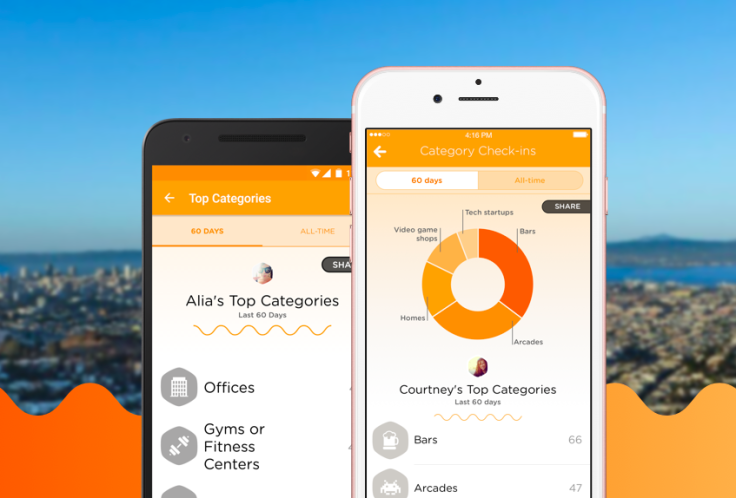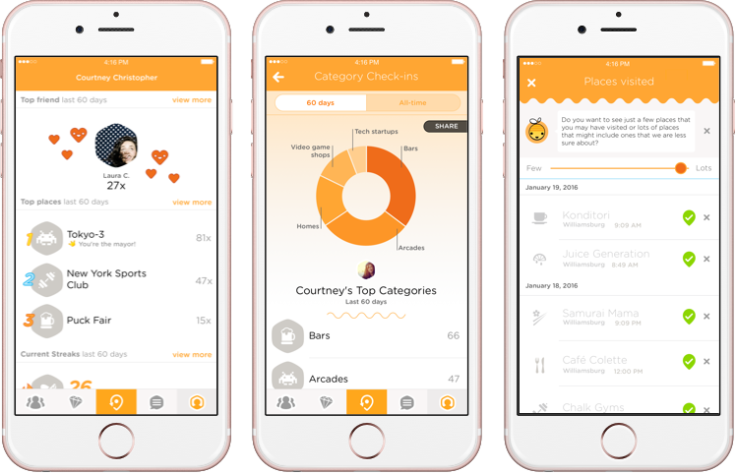Foursquare Launches Swarm 4.0 In Bid To Make The ‘Check-In’ Fun And Exciting Again

Foursquare doesn’t want to be a flop or a feature within another network, at least not yet. The original check-in app has been allowing people to share their locations since 2009 even as social networking giant Facebook created a similar function.
But Foursquare has come a long way since it skyrocketed to fame at the annual South by Southwest conference to its logo gracing the store windows of businesses worldwide.
But then the hype subsided. The download rate plummeted and the app fell from the top 100 in Apple’s App Store down to 1,250 in 2014. That year, Foursquare decided to break its product into two: Foursquare (for location tips) and Swarm (for check-ins). Again, the app’s rankings dropped, according to a chart from App Annie in Fast Company.
Yet, the fun is not over for Foursquare. In fact, the fun is exactly what Foursquare’s team says it has used to bring back engagement and interest in its apps. “I love products that surprise and delight people,” J Crowley, Foursquare’s vice of president, told International Business Times at the company’s headquarters in New York City. “We’re taking the extra time to make sure things animate. There’s sound effects now."
But beyond surprise and delight, Foursquare’s latest effort is a move into big data, the so-called quantified self that has given a rise to fitness trackers and personal finance site Mint.com. “It’s an incredibly powerful feature the more data you give us. It’ll tell you here’s what your story is like. This is just an amazing memory bank of information,” said Crowley, as he showed his revamped Swarm profile.
Foursquare on Thursday releases Swarm 4.0, which includes a complete overhaul of the app’s profile page. No longer is it simply a list of check-ins in chronological order. Now, the page includes sections for top place categories, most frequented locations, best friends and visit streaks. For example, a user could see how many bars had been visited in the last 60 days, or over all time, and break that up by type, such as cocktail bar and beer garden.

Foursquare’s team hopes these features will excite not only new users but inspire long-time users to check in even more. “If you’re just collecting the data and you can’t access it, then what’s the point of having it? You can see how it’ll be useful, reliving your memories,” Crowley said.
Indeed, Foursquare has built its business from data collection. Last year, the company released Pinpoint, a product for targeting ads based on location data and history. Foursquare has a massive database of locations and businesses based on its users’ check-ins. Pinpoint does not directly involve revealing a user’s individual data but rather offers a location system that is kept updated by its users to advertisers. All data is anonymized.
But there’s a question as to whether Foursquare users are aware of how their data is being used. When Foursquare split the apps two years ago, the company also turned on passive location tracking. That means the apps are constantly tracking a user’s location. A user can turn that feature off by going to the privacy settings and deselecting “Allow this app to use background location, including when the app is closed.”
But while some regulators and users may be wary of the practice and see it as creepy, location tracking and ad retargeting in this way is not illegal. “I don’t see it as any greater concern than what the current state of the law is in privacy and mobile,” said Barry Benjamin, a media and advertising attorney at Kilpatrick Townsend & Stockton. “Some argue that the law should regulate in medical and health data, but for the most part location data [like those] through Swarm and Foursquare is voluntarily provided. No one’s requiring you to sign up.”
But it’s not just useful for advertisers. Foursquare is selling the utility of it for users. Swarm product manager Tracey Churray suggested the information will be useful for “life-logging,” or setting personal goals. “You could see maybe all I check into is bars,” she said. “Maybe I should check into the gym more often.” The profile page is private to each user unless he or she chooses to share it.
Beyond these new data visuals, the updated app includes a feature called Weekly Swarm, which highlights a selection of check-ins over the last week. The section will show popular events, places, friends’ trips and new mayorships or stickers. For instance, in Crowley’s Weekly Swarm, he saw one of his friends was “on the road,” visiting London. “When you think about all the apps people use and how noisy they are, this is the opposite of that,” Crowley said.

The latest update comes less than a year after Swarm 3.0. Released in August, the revamped version brought back public mayorships, a leaderboard and stickers. These features were in previous versions of Foursquare but were discontinued when Swarm was first launched in 2014.
That decision frustrated power users. “What I’m interested in is, at what point are they going to recognize that the public is right and go back to what used to be normal?” Foursquare user and digital strategist Meredith Gould told NPR in July 2014.
And so last year, Foursquare went back to its roots, and it has paid off in app activity so far. The app has seen 40 percent more users checking in since August and has achieved record engagement. Swarm now garners 8 million check-ins per day and has 8 billion check-ins overall to date.
The company is now under new management. Founder and CEO Dennis Crowley stepped down in January 2016 and is now executive chairman. Jeff Glueck, formerly chief operating officer, took the role of CEO, and Chief Revenue Officer Steven Rosenblatt was promoted to president. “Foursquare is in great hands with both Jeff and Steven at the helm and our company is fantastically set up for success,” Dennis Crowley wrote in a blog post on Medium.
With the executive shuffling, Foursquare announced a new $45 million round of funding, led by Union Square Ventures, which reportedly cut the company’s valuation in half. Foursquare has raised $166.35 million over six rounds. However, revenue has grown by triple-digits in the last three years, Rosenblatt said in February 2015. Foursquare sells its data to enterprise clients such as with Pinpoint (a programmic ad system), Attribution (a measurement of online ads to offline traffic), Place Insights (data analytics) and Places (an API used by Apple, Twitter and 100,000 other services).
Unlike 2009, the company did not use SXSW as a launchpad for this new feature. “For a big, exciting launch like this one, we take all the time we need to do research, test (find bugs!) and polish until the product is something we’re really proud of,” Foursquare editor-at-large Sarah Spagnolo wrote in an email.
© Copyright IBTimes 2025. All rights reserved.




















